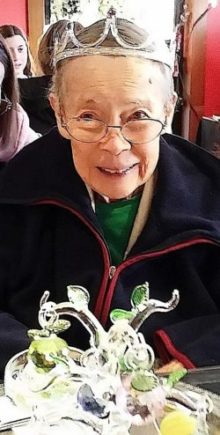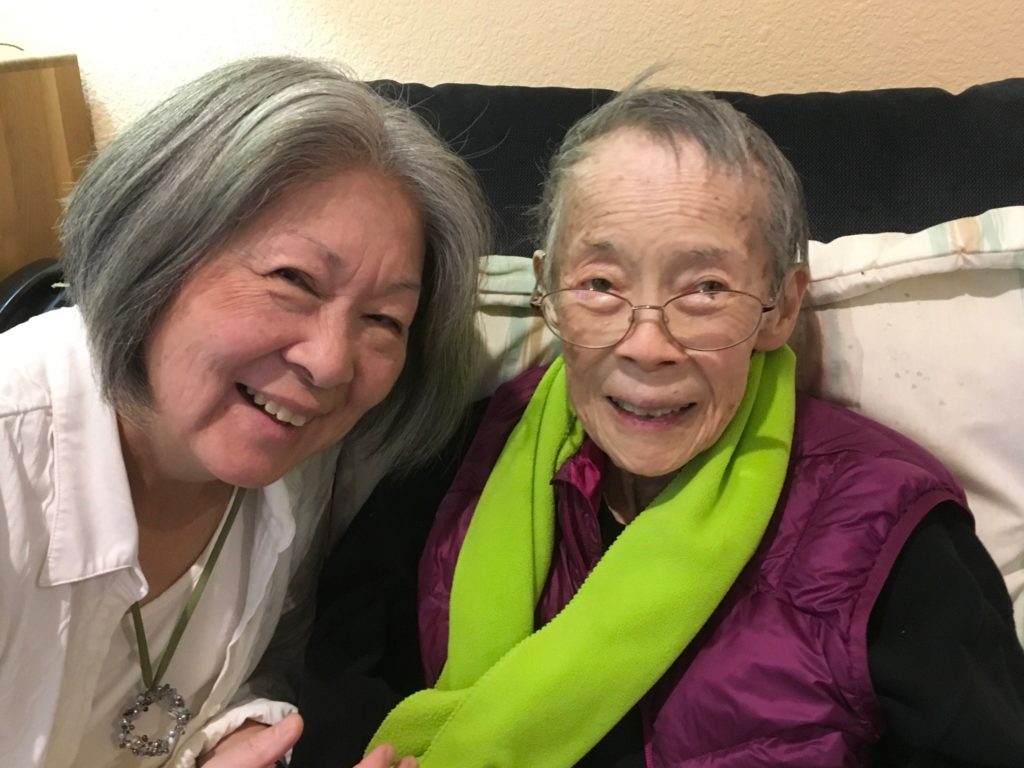We most often hear the phrase “Until Death Do Us Part” at weddings, when a couple commits to fidelity and love for one another until one of them dies. The traditional wedding vows say nothing about what accompanying someone to death involves. And the vast majority of us have no training in what the dying process involves and what is required to sit with a loved one as they are dying.

Mom at her 95th birthday party, August 2016
My mom died in December at age 95. In reflecting on the end of her life, “until death do us part” is the phrase that keeps coming to mind. I think our bonds to parents and family are as deep as any marriage vow, and they span more of our lifetime.
Mom really showed up for me all through our lives, as did my dad. She taught me to how to play Four Square well enough so kids would stop making fun of me on the playground. She fried egg sandwiches for the two of us, and we’d talk and laugh late into the night. Later, Mom cooked favorite foods for my kids, took them to the playground and wrote them birthday cards.
Just over six years ago I switched roles with my parents. They moved into assisted living and I took on the parent role, managing all their medical, financial, legal, housing and day-to-day needs. After my dad died in 2011, my mom carried on. Her short-term memory declined but she still loved going out for Japanese food, talking with the ladies at her meal table, and joking about herself as “the old lady.” She marveled at her great-grandchildren.
As her memory and her mobility declined, the gravitational field around Mom increased: as family we were pulled more closely into her orbit. She wanted to spend more time with us, going to the Japanese restaurant, singing “Moon River” or just keeping her company. In classic form, she was still trying to offer us, and everyone who visited, sodas or snacks. Her hospitality was one of her most enduring traits.
As I was spending more time with Mom, I was also helping care for my grandson who was born just over a year ago. One day I would be walking him in the stroller and the next day I would be taking my mother to lunch in her wheelchair. Though distinct, their needs for reassurance, help with basic transport and food were very similar. As my mom’s condition declined, I felt her emotional needs more, the way a young toddler keeps reaching out for food/love/being carried. In all honesty, I felt more and more emotionally tired. While my grandson tired me out physically, spending time with him was emotionally restorative. With Mom, the physical aspect was easier but it drew down my emotional reserve. I’m grateful that my family rallied around to take turns being in my mom’s orbit. She loved their visits, and it served as a respite for me.
As my grandson’s abilities and strength increased, my mom’s decreased. I began to think about all of the time and energy she had devoted to me as a child. I drew on this gratitude to keep me going: communicating with caregivers, navigating the transition to “pull up” diapers, and coordinating with our hospice nurse.

Me and Mom, three days before she died.
My mom’s strength declined noticeably after Thanksgiving, so we spent time with her at home rather than going out for Japanese food. She still loved listening to music, so we brought our Christmas CDs to play. I filled her room with Christmas decorations because she could still see and enjoy the twinkling lights. I knew my mom wouldn’t live much longer, and I wanted the space to be warm and welcoming for her and for everyone who visited.
In early December, two days after she had stopped drinking fluids, Mom was clearly in pain. When I asked about morphine, the nurse explained that she could administer it until 11pm when she went off duty, and that only the hospice nurse or a family member could administer it between 11pm and 8am the next morning. I knew I had to stay the night to administer the morphine so I went home, packed my bags, and returned.
The nurse showed me the bottle and how to measure the dosage. At that point a curtain parted and I stepped into another world. I moved past doctors, nurses, regulations and everything built up around the practice of medicine. It was just Mom, me, a small bottle of morphine and my limited experience administering prescription drugs as I faced navigating a long night.
I started on the base dosage — every four hours — but after the second dose she was still in pain. The nurse said it could take 30 to 40 minutes to take effect. I held my mom’s hand as she cried out and watched as the clock hands moved so, so slowly. Sitting with her and being unable to stop the pain was wrenching for me. I held her hand, I prayed, I sang “Moon River” “Silent Night” “Away in a Manger” and then I just hummed. Mostly, I focused on being fully present — thanks to 25 years of Shintaido, a martial art that trained me in meeting people soul-to-soul.
The base dosage was not relieving her pain, so I decided to administer the dose every hour and watched the clock hands move as my mom alternated between calling for help, resting quietly and saying, “Itai!” (Japanese for “it hurts!”) I called hospice again when I was completely at a loss for what to do, and they said “double the dose.” Finally, Mom quieted down and seemed peaceful — on the outside at least. She rested quietly during her last three hours and slipped away in the morning.
I had been up all night, alone with Mom most of that time. Listening to her cry out and not knowing how to help was one of the most difficult things I’ve ever done in my life and the hardest since giving birth to my son 34 years ago. But I feel honored to have done it. Not many people have the opportunity to give this gift, this accompaniment to the very end of life. It was also a gift to me.
I spent time with my daughter as she labored many hours before my grandson’s birth. I know now that it is a huge effort to bring life into this world and sometimes a huge effort to leave this world.
The opinions expressed in this article are those of the author and do not necessarily reflect those of the Diverse Elders Coalition.

